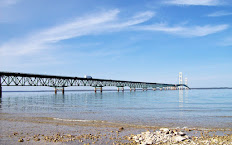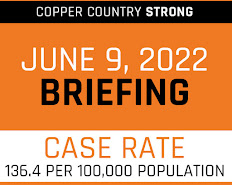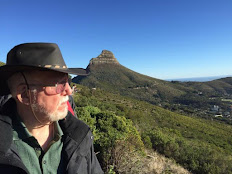By Diane Miller*
Outside Enbridge's recent "barbecue" in Traverse City, Mich., Greg Reisig and June Thaden hold signs showing their solidarity with the Oil and Water Don't Mix campaign to shut down Enbridge's Line 5 pipeline under the Mackinac Straits. (Photos by Diane Miller for Keweenaw Now)
TRAVERSE CITY -- Why would the Enbridge energy delivery company host six public barbecues in three days in Manistique, Mackinaw City, Petoskey, Charlevoix, Gaylord, and Traverse City?
As we know, Enbridge is the Canadian company that manages the now infamous Pipeline Number 5 -- two 62-year-old pipes, about 1000 feet apart and ranging from 100 to 270 feet deep in the Mackinac Straits. These pipes are transporting 540,000 barrels of crude oil and natural gas liquids through the bottom of the lake every single day. Most of the people who live near these pipes do not want them there. But barbecues?
On June 23 I took a trip to find out. While I was driving a couple of hours to Traverse City, to check out the sixth and final barbecue of the series, I was picturing a picnic; and since I really didn’t know my way to Hemming Hall, the advertised venue, I figured I’d just follow my nose to the barbecue grill. That didn’t quite happen, but as I was negotiating Traverse City’s summer bumper-to-bumper traffic I knew I was in the right place before I saw the hall. On the lake side of the highway, dressed in blue t-shirts, were a half dozen smiling people holding something that has now become familiar: Signs with blue letters that read "Shut Down Line 5 Pipeline."
Welcoming positive reactions to her sign from passing motorists in Traverse City is Denise Sica. "This issue is a no-brainer," Sica said. "It is so obvious that there is a potential disaster that we can prevent. Our society is constantly going around cleaning up messes after they’ve occurred, which is ridiculous when we have the ability to prevent something."
In a minute we’ll find out why Enbridge was hosting the barbecues. First, why were the people in the blue shirts smiling?
It might be partly because most of the cars crawling along in the bumper-to-bumper line were either smiling, honking, waving, or holding their "thumbs up" out of their vehicle windows toward the sign-holders, indicating solidarity, or at least approval for the "Shut Down Line 5" message.
Although the sign-holders indicated they weren’t interested in entering the building to eat Enbridge’s barbecue, June Thaden of Traverse City, who is a member of Northern Michigan Environmental Action Council (NMEAC) and has been working with the Oil and Water Don’t Mix campaign, was eager to share some good news. The big news on the sign-carrying line was that Mackinac Island’s mayor, Margaret Dowd, as well as Dan Musser, the owner of Mackinac Island’s Grand Hotel, are calling for the pipeline to be shut down -- and the Detroit Free Press that very day had published Musser’s Op Ed.**
They were also smiling because President Obama had just signed a bill to reauthorize pipeline safety measures and, inspired by concerns over Pipeline 5, to extend special safety provisions for pipelines in the Great Lakes.***
Miriam Owsley of the Groundwork Center for Resilient Communities (formerly Michigan Land Use Institute) displays her sign in Traverse City. "Instead of spending billions of dollars on cleanup, why not stop imposing giant risk on people who depend on the Great Lakes?" she asked.
But why would Enbridge hold a barbecue?
Becky Haase, Enbridge’s Senior Public Relations advisor, said that Enbridge brought in about 30 employees and subcontractors to staff the event, which was arranged like an expo -- equipment on display outside, a cafeteria-style serving line and booths lining the inside of Hemming Hall, a small community event venue.
Visitors meet with Enbridge representatives inside Hemming Hall in Traverse City.
The goal of the event was to clear up what Haase called false beliefs.
"There’s been a lot of misinformation circulating about Enbridge Line 5 and how we do business," she said. "We want to share our practices with the communities near the pipeline."
Becky Haase, Enbridge’s Senior Public Relations advisor.
What kind of misinformation?
According to Haase, people are saying the 60-year-old pipeline needs to be replaced because of its age.
"Not true!" Haase said, adding that people believe "because we had a spill in Marshall, this pipeline is ready to burst!"
If she is in the business of correcting that kind of cause and effect error, then I am very glad she is doing her work. But I’ve been talking lately with a lot of concerned people lately, and I had not heard logic that simplistic. It might be more accurate to say this: Although the state of Michigan granted the easement for the pipeline in 1953, most people didn’t pay attention to it until July 2010 when Enbridge’s Pipeline 6B broke open; and, because of a combination of structural problems and human error, it spilled more than a million gallons of crude oil into the Kalamazoo River near the town of Marshall, Mich. This spill is known as the largest inland oil spill in U.S. history. People don’t want to see another one.
Sam Getsinger, who is running for commissioner of Leelanau County, said, "We’re all on the damn planet. We need a planet to support our children. When I say that we should shut down the damn pipeline, they say 'we get it.' We get it but are they going to do it? Hell no." Her sign says, "There are alternatives to oil and gas. There is no alternative to water."
Barry Lishawa of Traverse City put it this way: "The environmental risk is unacceptable here where we have 20 percent of the world’s fresh water. Line 6B was 15 years younger; they replaced it only after it burst. We need to be proactive, not reactive."
I also heard attendees refer to a variety of details that have held up, including specifics from the 1953 easement, the amount of insurance Enbridge has, the number of manufacturing defects in the thickness of pipeline 5, the structural wear and tear that has taken place according to published photographs of the National Wildlife Federation’s 2013 inspection, and the University of Michigan research that uses knowledge of currents and other lake attributes to predict the range of a potential spill.****
Attendees pushing for the pipe to be shut down also had figures -- which I verified through the Chicago Tribune and elsewhere -- about Enbridge spills in North America, a total of 44,475 barrels over a decade. The Tribune also cited property damage valued at $928 million.
Haase, however, wasn’t able to give me the kinds of numbers I asked for. Neither could any of the other Enbridge representatives or their subcontractors I met with at the event. But she did tell me this: All releases over five gallons need to be reported (releases under that amount do not), the pipeline safety record is similar to the commercial airline industry, the pipelines are as good as new, and Enbridge has made a huge investment in safety equipment -- in part to let anyone else who has a spill use it.
This is interesting -- that the equipment would be used by someone else. Does anyone other than Enbridge move oil in the area? She didn’t know.
Stephen Lloyd, Enbridge Emergency Response manager, said, "In the unlikely event of a spill we have the best technology possible to attack the oil."
Stephen Lloyd, Enbridge Emergency Response manager, left, chats with Barry and Linda Lishawa of Traverse City.
The company has just spent $7 million on equipment, which includes eight
current busters. The first two arctic brushes in the world are going to
be at the straits.
The Current Buster is one of the technologies Enbridge is investing in to scoop up spilled oil.
This polypropylene brush looks like the one I have in my garage. The brushes spin around and scoop up spilled oil.
"Leave it better than you found it," is the motto, Lloyd said.
Is that possible? What about possible wildlife deaths?
"That’s remediation, and that’s a different thing -- not what we do," he replied.
Better than you found it?
"We’ve been getting good feedback from people," Haase said. "They leave commenting, 'This is not necessarily what my neighbors are saying.'"
I think I can see why.
Some attendees represented NMEAC, the Groundwork Center for Resilient Communities (formerly Michigan Land Use Institute), the Michigan Environmental Council, and Occupy Traverse City. Others were there as citizens without a formal affiliation. They did not seem misinformed; rather, their perspective was different than Enbridge’s.
David Warren of Occupy Traverse City said his group, which meets every Saturday, takes on economic, environmental and social issues, including Line 5.
"I’m just a diehard activist for the long haul," Warren said.
David Warren, an activist member of Occupy Traverse City, attended the Enbridge barbecue.
Like many of the approximately 50 guests, Bill Hansen, a member of the Northern Michigan Environmental Action Council (NMEAC), said he was there to participate as someone who has researched the pipeline issue and knows what is going on.
Bill Hansen, a member of the Northern Michigan Environmental Action Council (NMEAC), brought his expertise on pipelines to the meeting.
"It is a democracy; it is our chance to be listened to," Hansen said.
Trent Wetmore, Enbridge director of operations, said he was happy to engage in conversations with people who understand how pipelines work.
"We can take it to the next level," he said. "They leave feeling positive and people provide different perspectives."
But might Enbridge use those perspectives in their planning, I asked. Wetmore looked confused.
I, too, was flabbergasted by my own reaction to the equipment investment -- so different from what was intended. Seeing this stuff makes an eventual spill seem more like a reality, even though the technology is designed to calm our fears. The Enbridge folks delivering these messages seemed like genuinely nice people who believed in what they were doing, but they frightened me with their lack of big picture understanding.
Mark Ploen, environmental division vice president for Qualitech, an environmental cleanup company, said he provided a gap analysis for Enbridge in September 2015.
"They were lacking in open water and ice responses," Ploen noted. "They didn’t have any offshore. They were operating legally, but needed to do better."
Mark Ploen, environmental division vice president for Qualitech, an environmental cleanup company, said he provided a gap analysis for Enbridge last September.
A day later I was still trying to understand the evening -- what seemed like a visit to an alternate universe. I called Oil and Water Don’t Mix and reached Bill Latka, who told me he was at the event for a few minutes.
In that short time he got it: "They’re just doing their jobs," he said. "They don’t want an oil spill either. But there is a difference between not wanting a spill and not having a spill. What they don’t understand is that a leak is not acceptable. And the only way to prevent a leak is to not have oil there. Their job as a corporation is to make money. Our job is to protect what is priceless."
Notes:
* Guest author Diane Miller is a former Keweenaw resident and former Finlandia University communication professor. She now teaches at a community college downstate.
** Click here to read Dan Musser's Op Ed.
*** See the June 22, 2016, Detroit Free Press article, "President Obama signs bill with Great Lakes pipeline protections."
**** Click here to see a computer simulation that demonstrates what could happen if there were an oil spill at the Mackinac Straits.
Subscribe to:
Post Comments (Atom)































































































































No comments:
Post a Comment